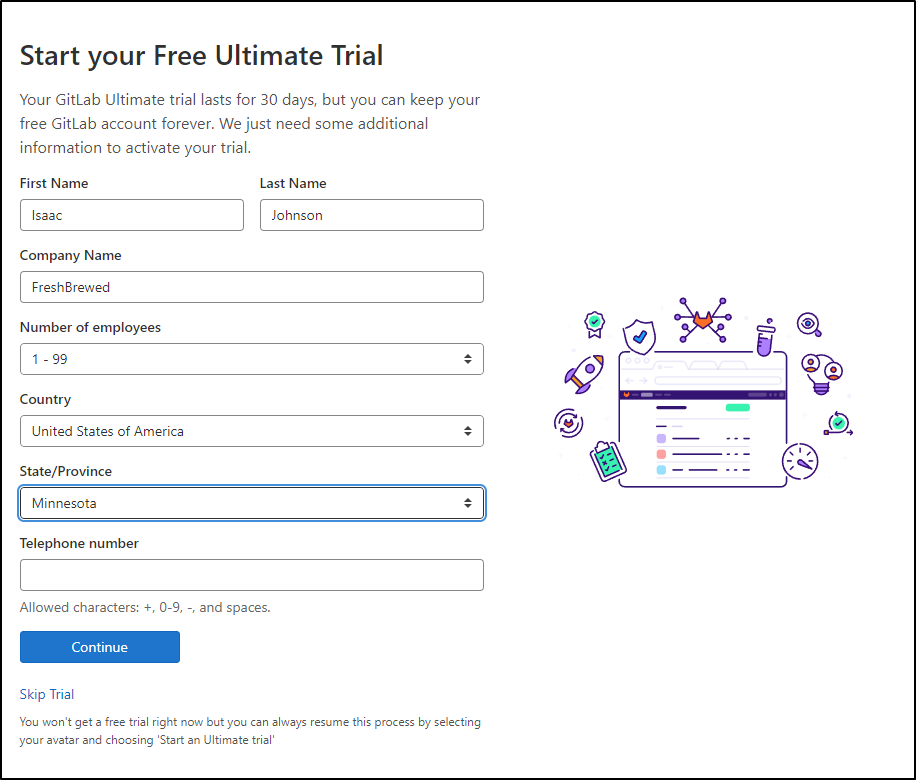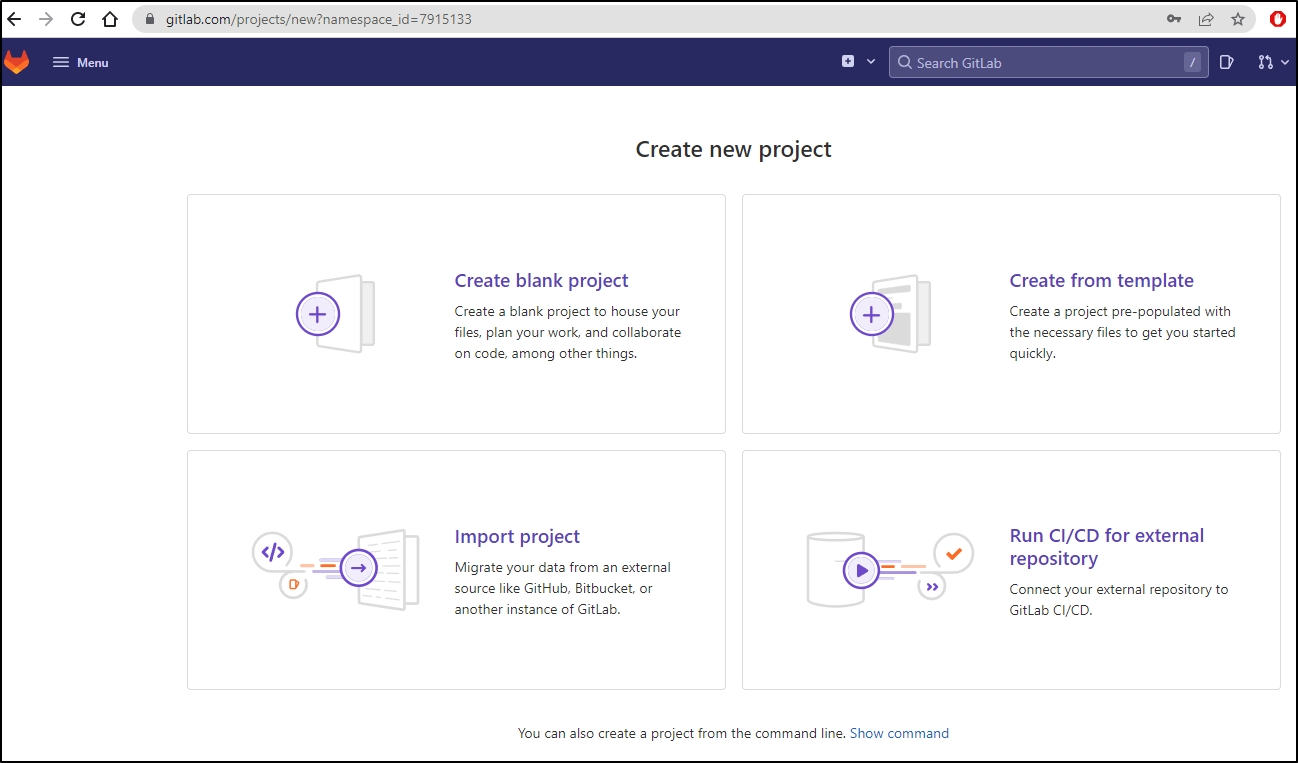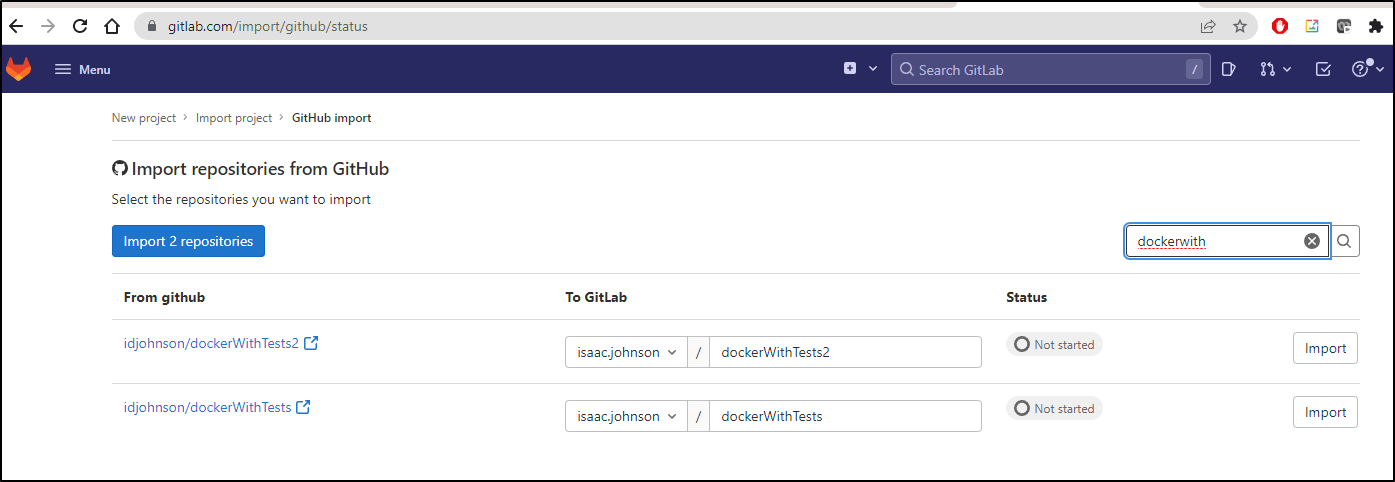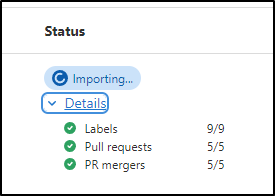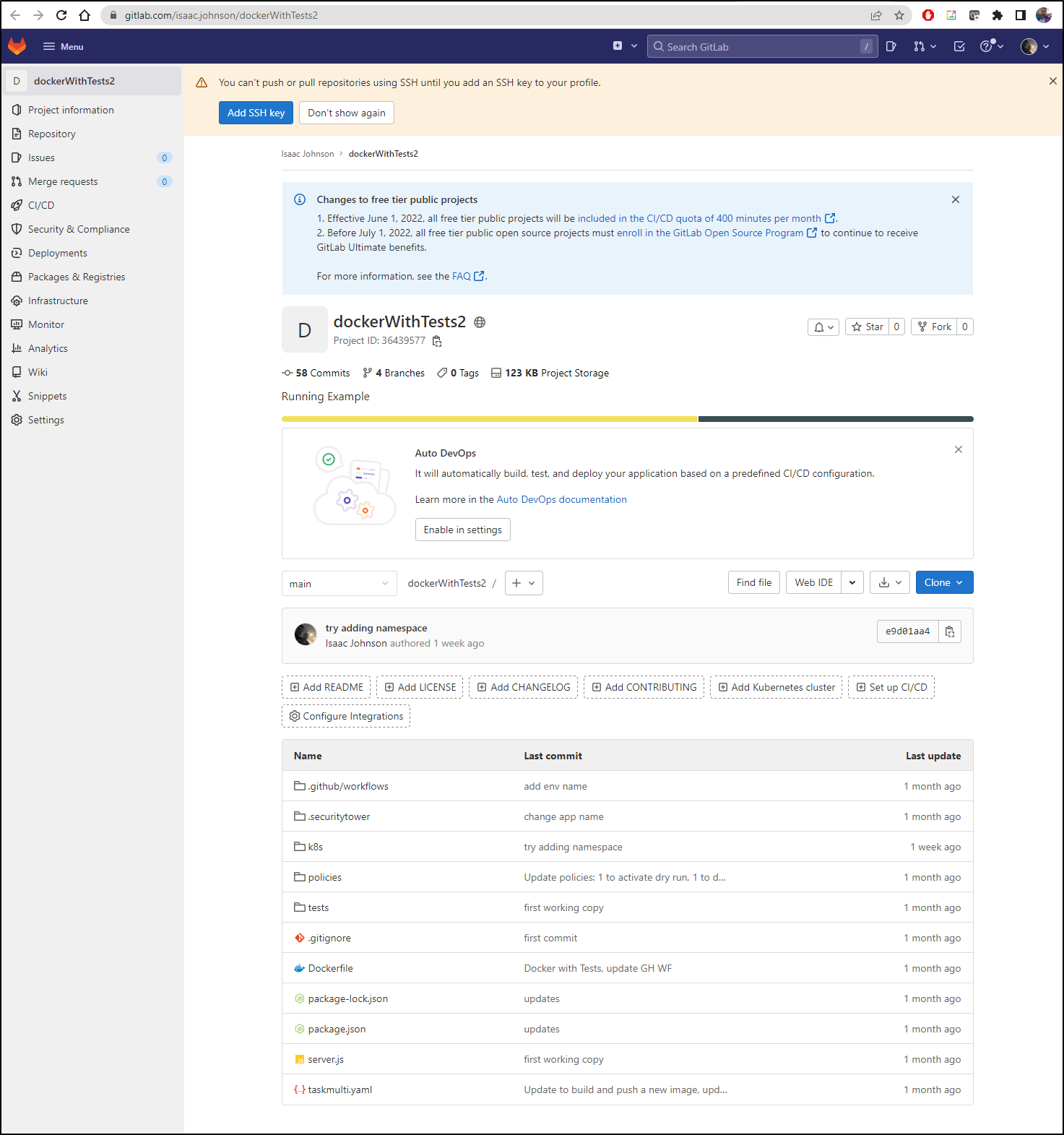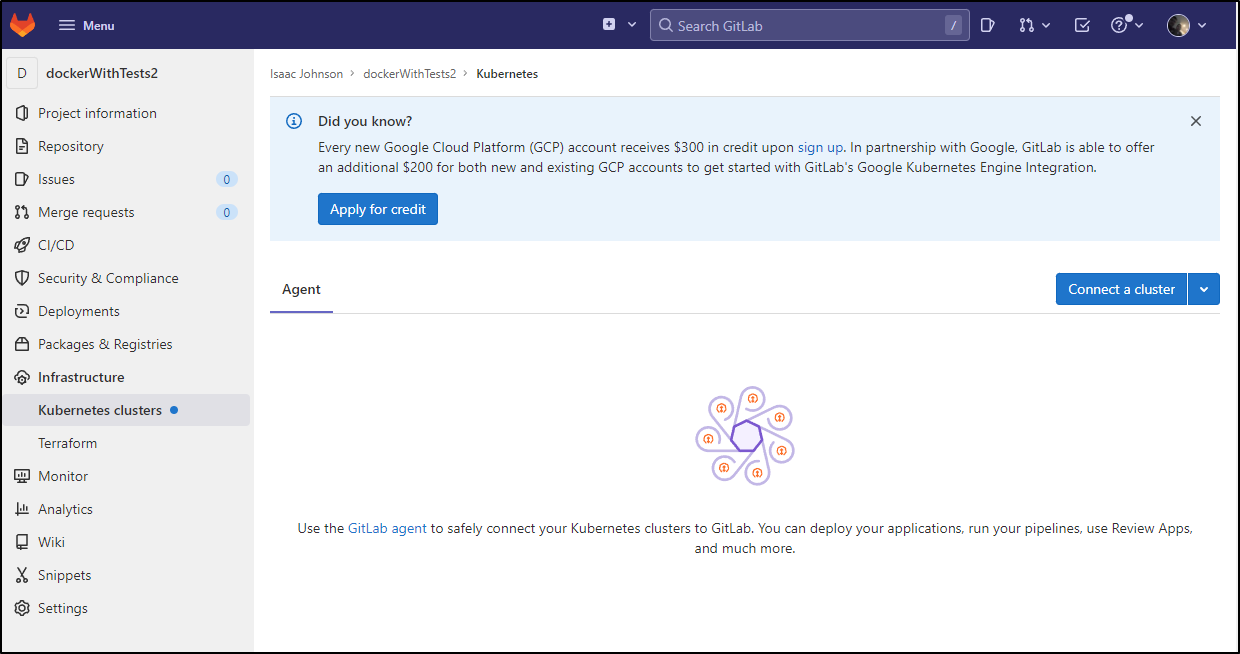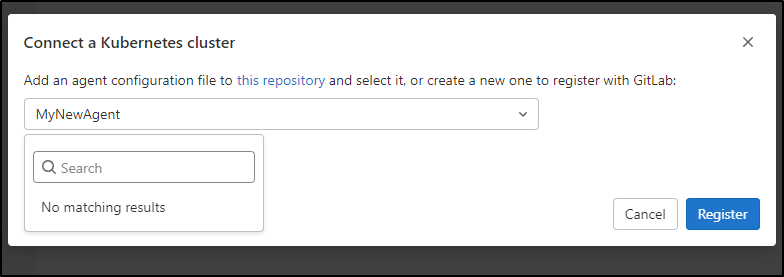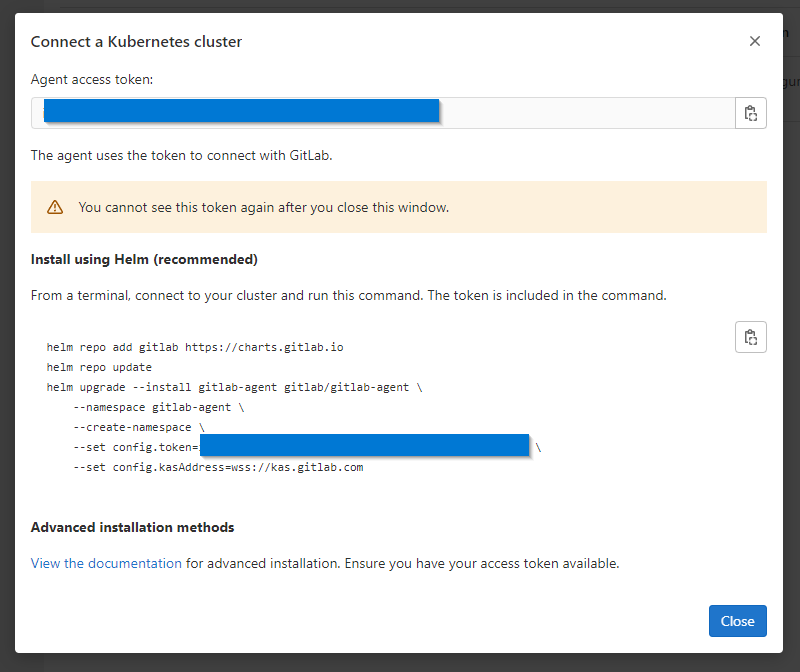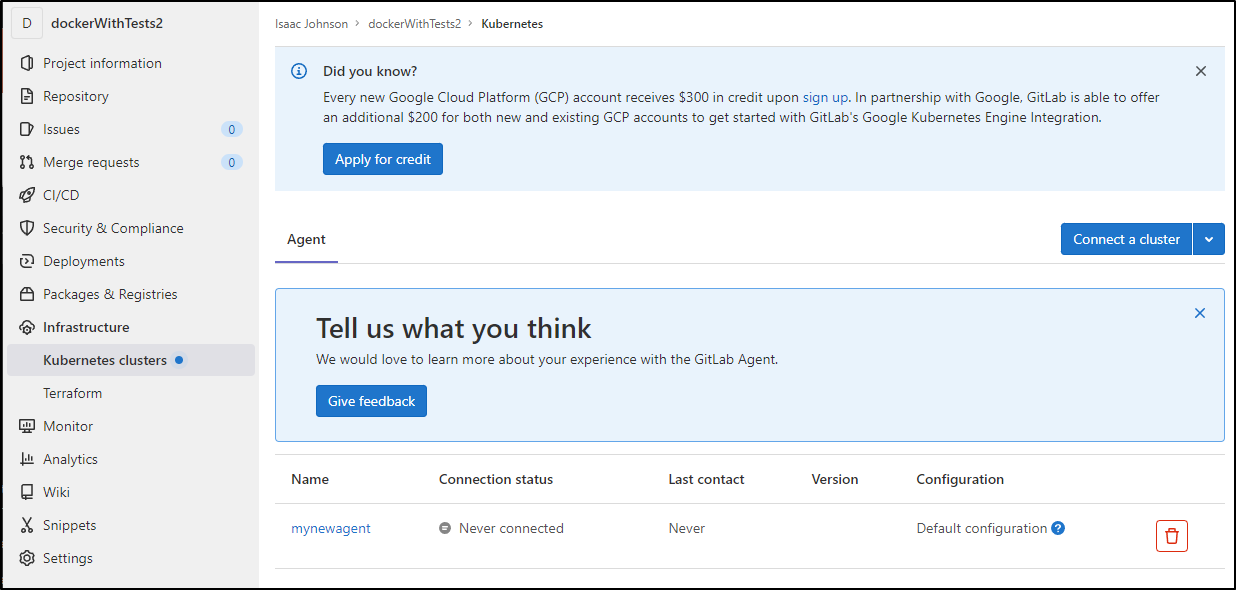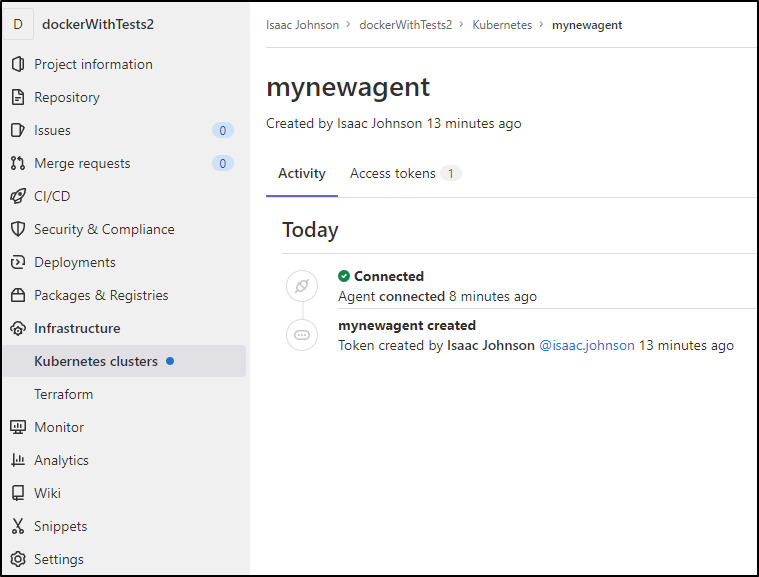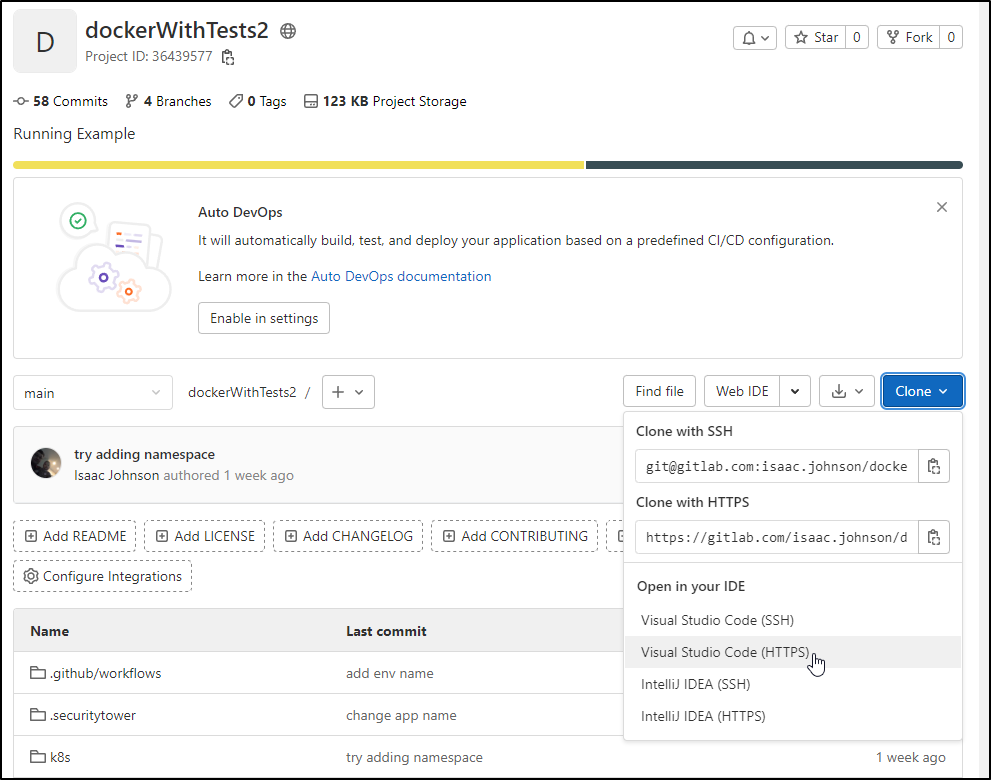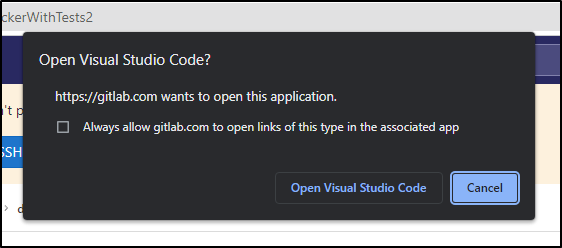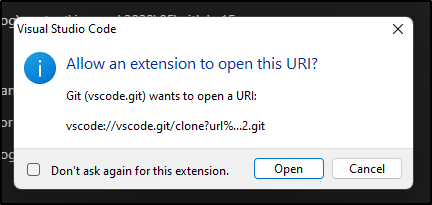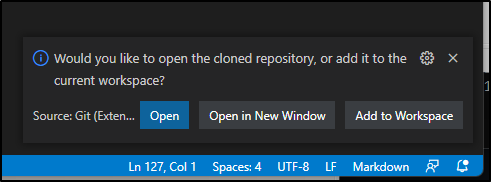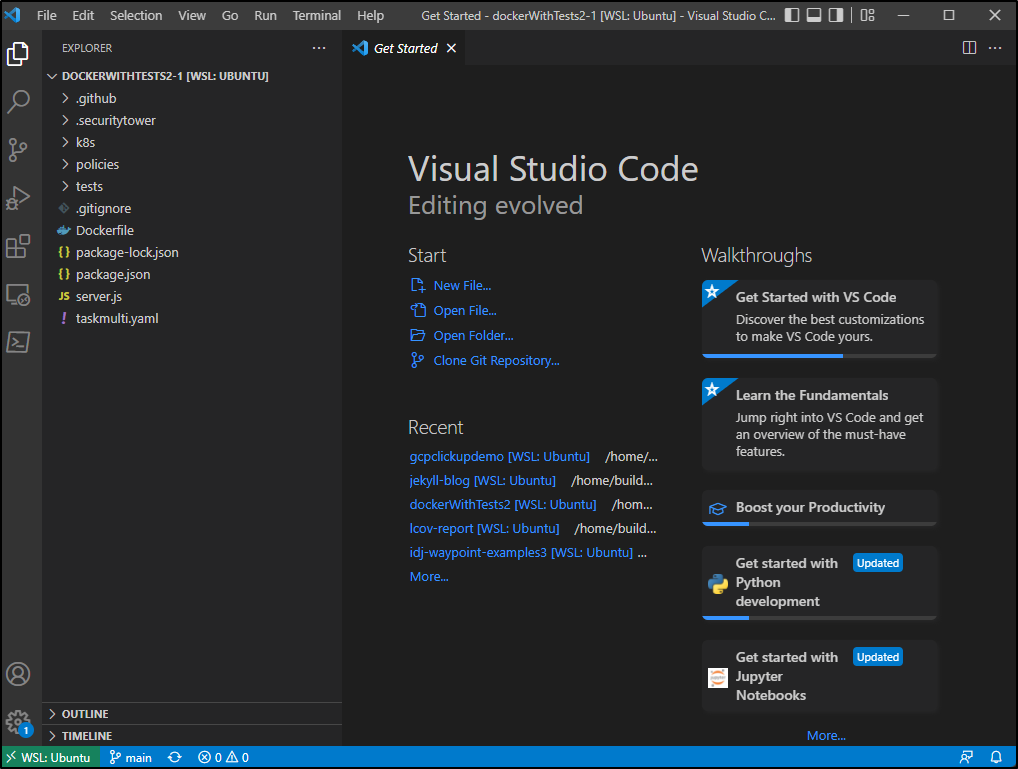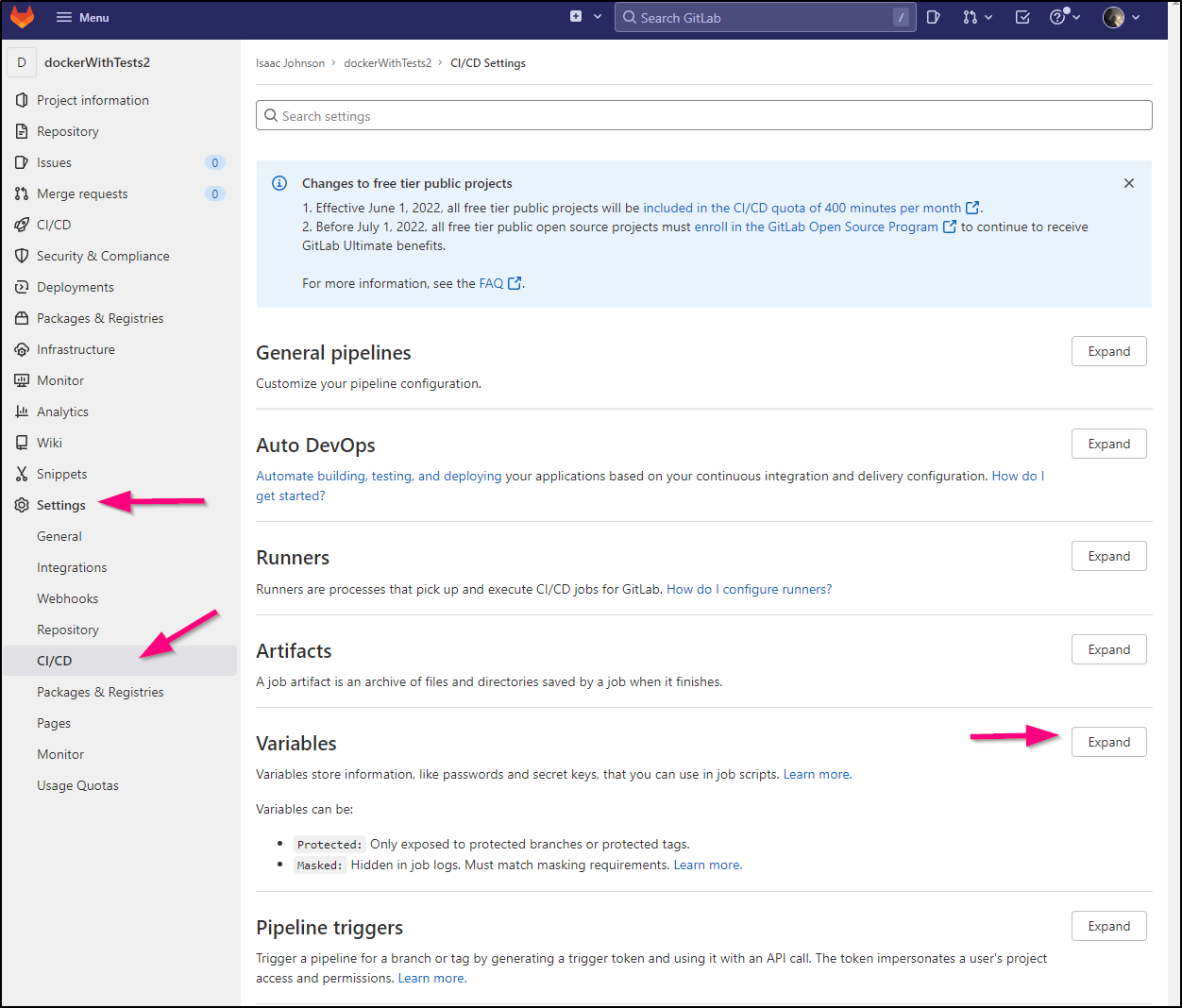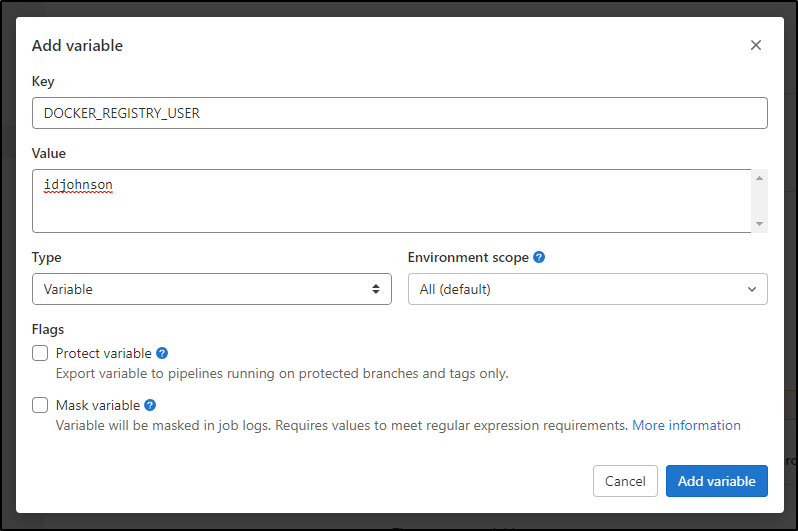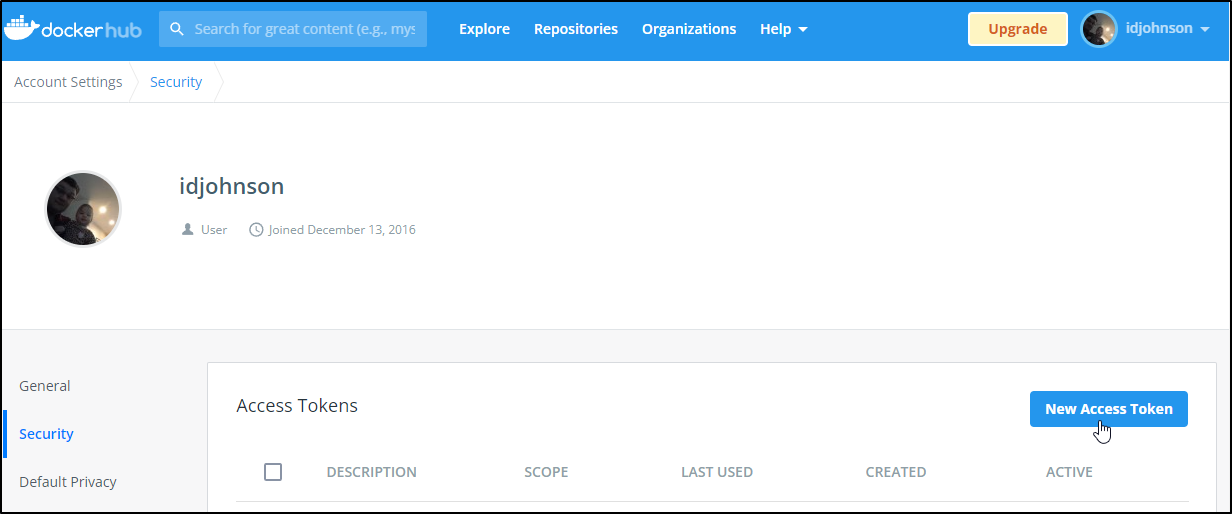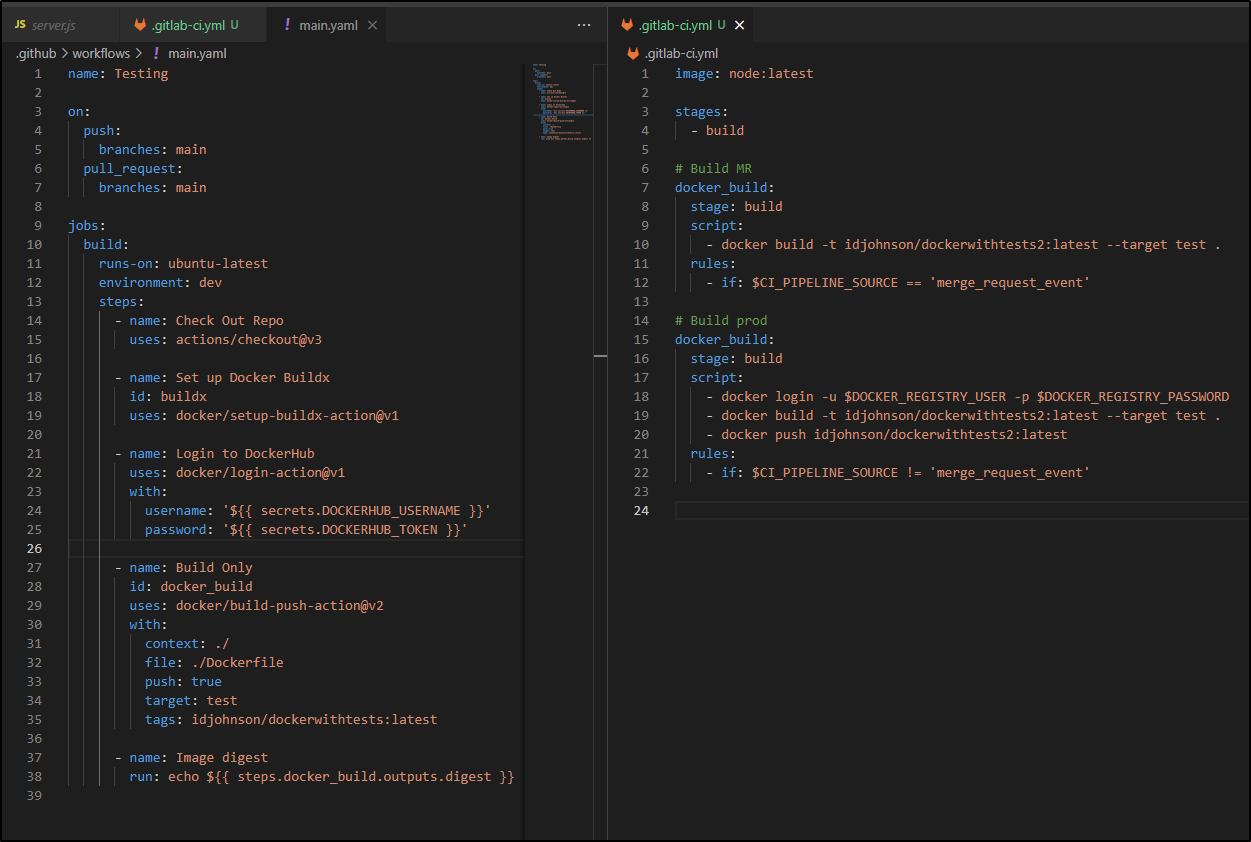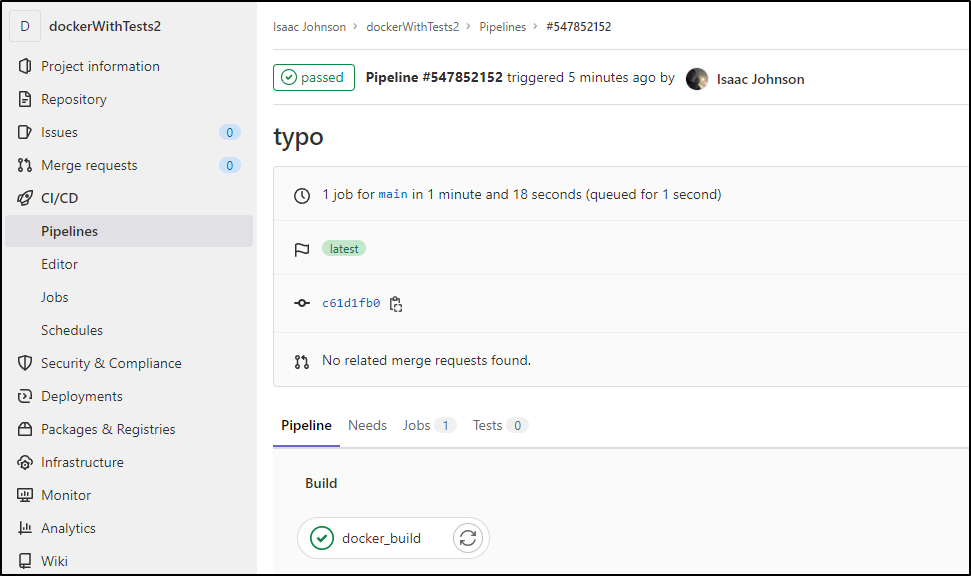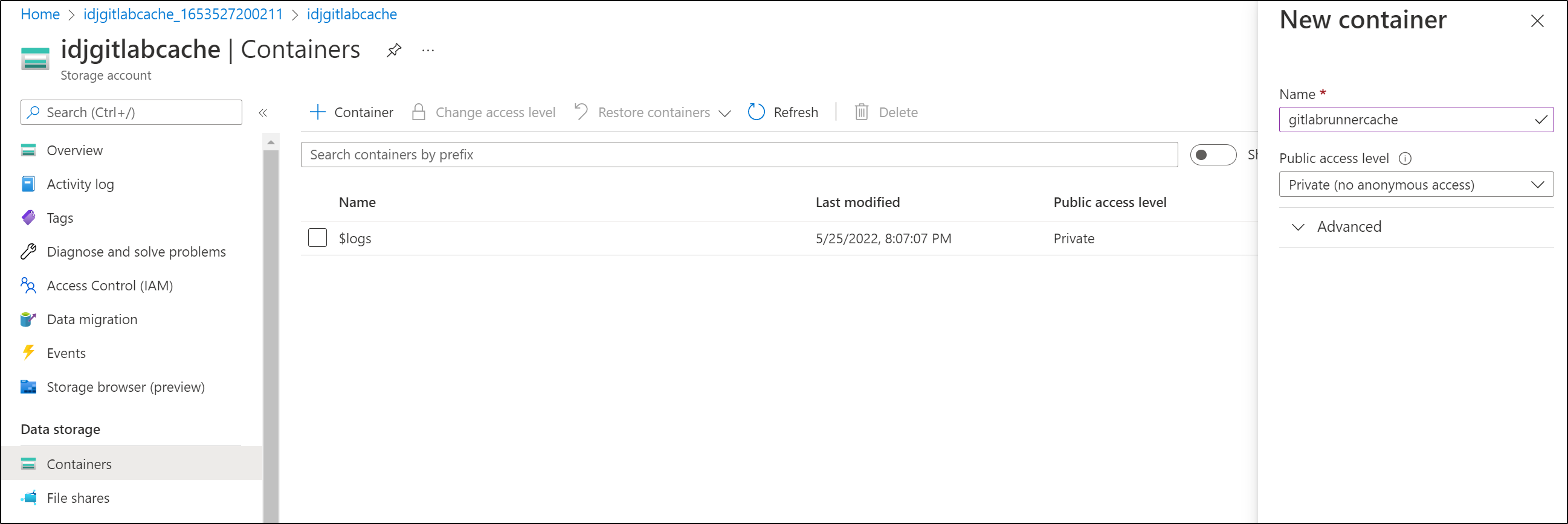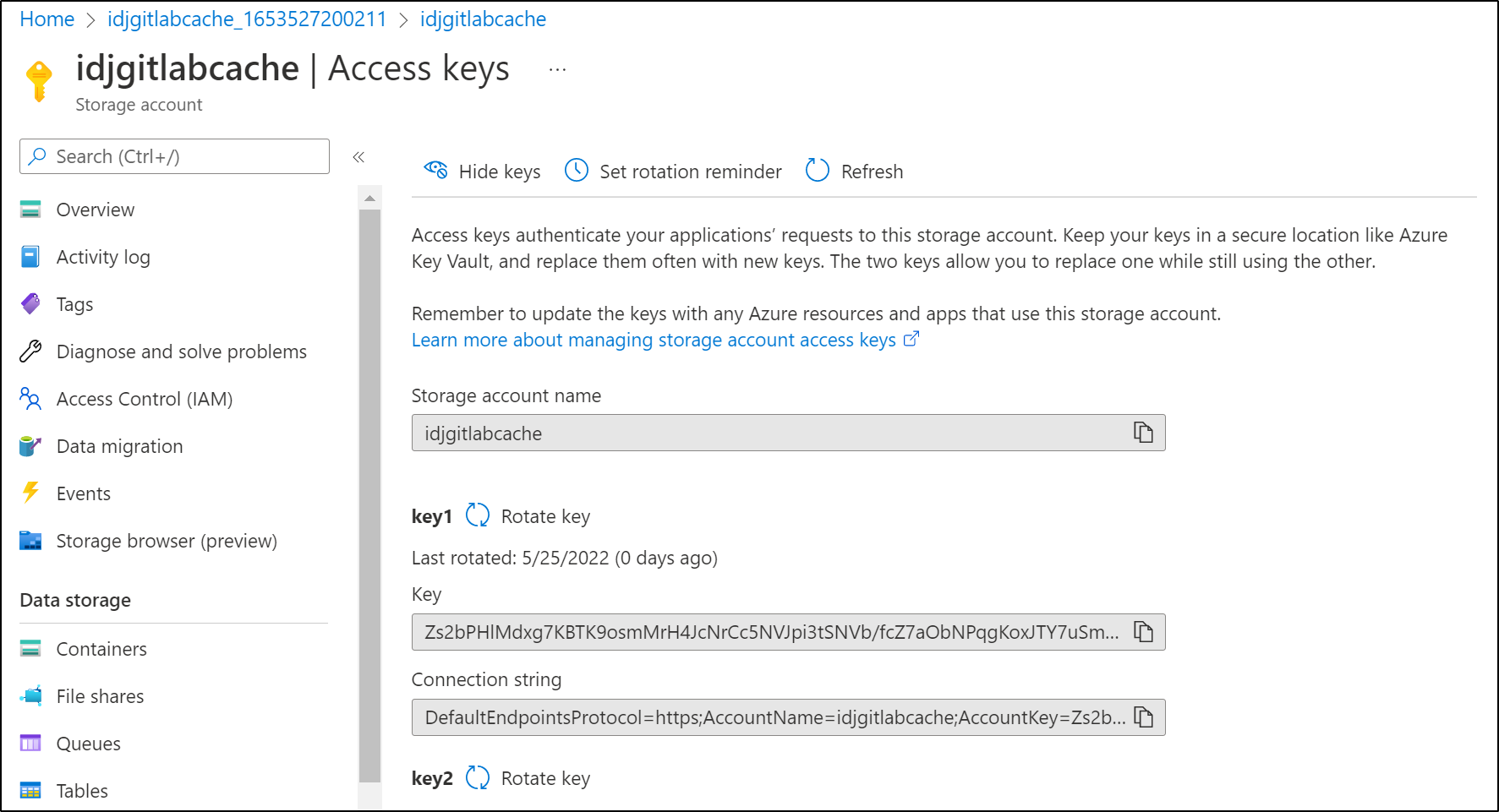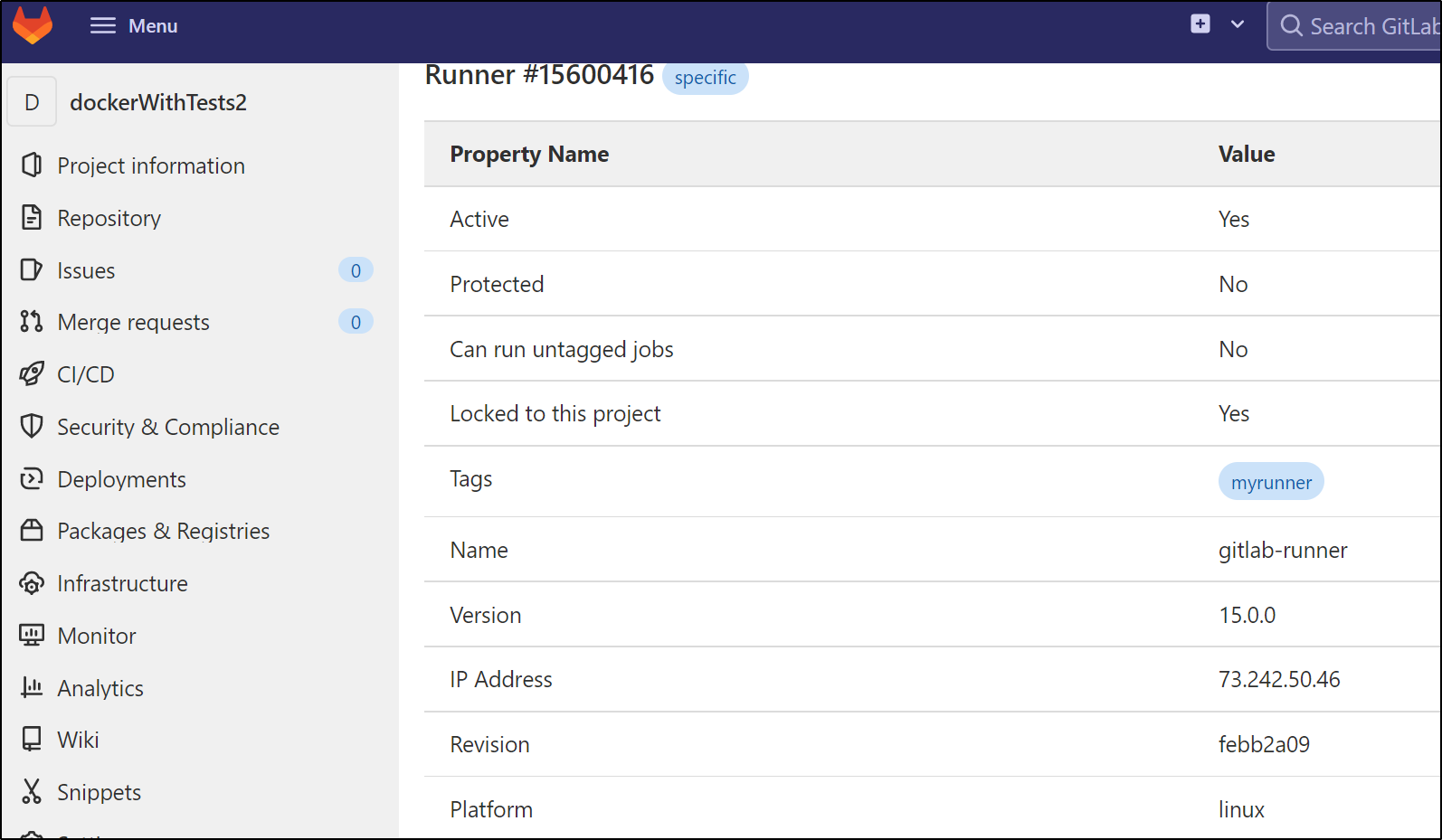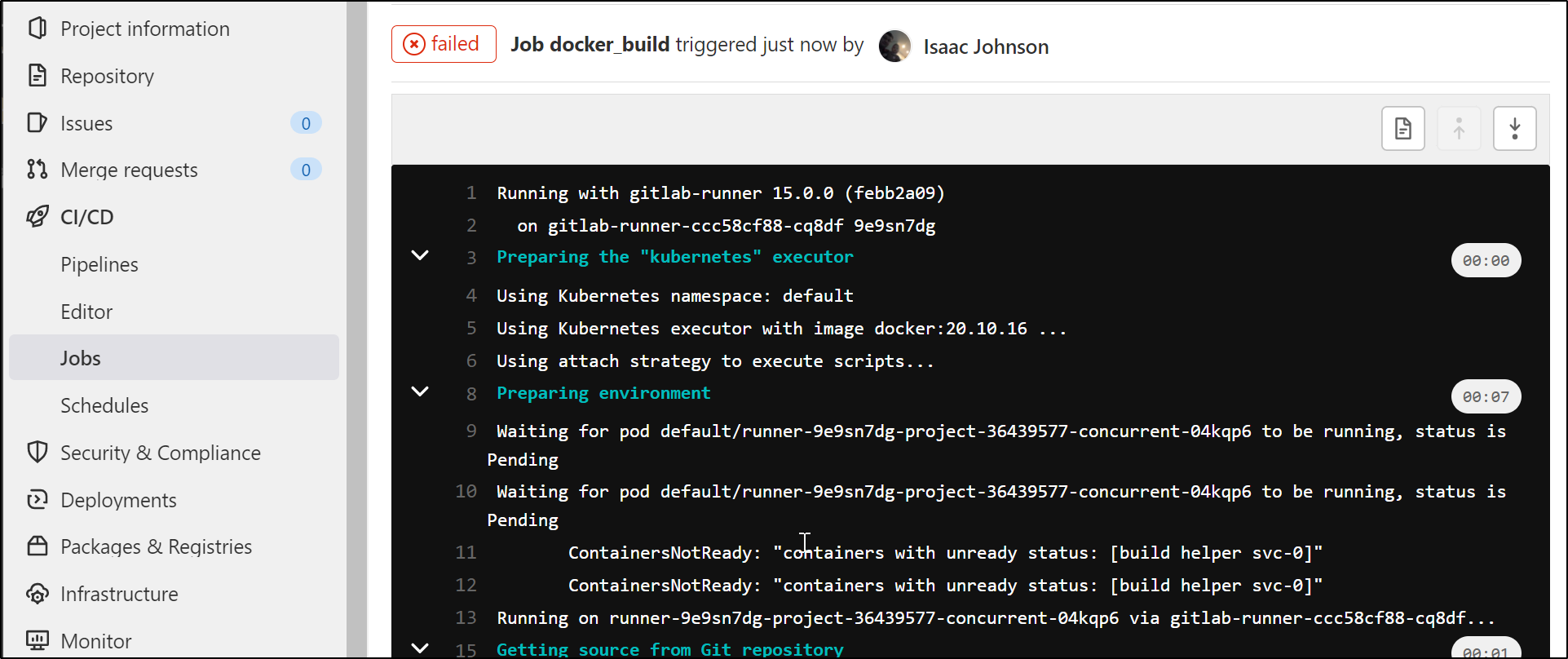Published: May 25, 2022 by Isaac Johnson
Gitlab has been steadily introducing many new features and most recently with v15.0, adding some observability. We last used it for ClickUp demo work back in 2020.
We are going to signup and start a trial of Enterprise. We’ll migrate in a Github repo and setup a CICD pipeline. We’ll setup private runners and (attempt) to get GitOps going.
Signup
We can signup on Gitlab.com. In my case, it just enabled the 30d trial of GL Enterprise.
From there I can see the GL Projects I already made which shows GL doesn’t purge old repos
Importing projects
Let’s assume we have a repo out in Github already and we would want to import it. We can choose new project then “Import Project”
I’ll choose Github in this case
I’ll need to auth to Github - either interactively as an app or with a PAT
I can thin the list down with the filter to find a repo I want to import. In this case, the dockerwithtests2
When I click import, I’ll see “pending”
I can expand and see the specific things being imported
When complete, I can go to the project and indeed, see all of my ojbects are now there
Connecting a cluster
Next, we’ll want to connect a cluster. I should note that there is a promotion to use GKE that offers an additional credit presently.
The UI here is a bit funny. It says you can type a name to create a new agent, but it’s a drop down. You have to click the drop down, then type a new name in search to enter a new agent name
Then we can move on to Register (it wants all lowercase, fyi)
Next I get a token and helm invokation to add the cluster agent
$ kubectl get nodes
NAME STATUS ROLES AGE VERSION
isaac-macbookair Ready control-plane,master 513d v1.23.3+k3s1
builder-hp-elitebook-850-g1 Ready <none> 208d v1.23.3+k3s1
builder-hp-elitebook-850-g2 Ready <none> 203d v1.23.3+k3s1
hp-hp-elitebook-850-g2 Ready <none> 228d v1.23.3+k3s1
anna-macbookair Ready <none> 401d v1.23.3+k3s1
builder-macbookpro2 Ready <none> 141d v1.23.3+k3s1
isaac-macbookpro Ready <none> 513d v1.23.3+k3s1
$ helm repo add gitlab https://charts.gitlab.io
"gitlab" has been added to your repositories
$ helm repo update
Hang tight while we grab the latest from your chart repositories...
...Successfully got an update from the "azure-samples" chart repository
...Successfully got an update from the "uptime-kuma" chart repository
...Successfully got an update from the "sonarqube" chart repository
...Successfully got an update from the "kuma" chart repository
...Successfully got an update from the "kubecost" chart repository
...Successfully got an update from the "epsagon" chart repository
...Successfully got an update from the "sumologic" chart repository
...Successfully got an update from the "datadog" chart repository
...Successfully got an update from the "nginx-stable" chart repository
...Successfully got an update from the "harbor" chart repository
...Successfully got an update from the "rancher-latest" chart repository
...Successfully got an update from the "incubator" chart repository
...Successfully got an update from the "gitlab" chart repository
...Successfully got an update from the "newrelic" chart repository
...Successfully got an update from the "dapr" chart repository
...Successfully got an update from the "myharbor" chart repository
...Successfully got an update from the "bitnami" chart repository
Update Complete. ⎈Happy Helming!⎈
$ helm upgrade --install gitlab-agent gitlab/gitlab-agent --namespace gitlab-agent --create-namespace --set config.token=iafsdfasdfasdfasdfasdfasdfw --set config.kasAddress=wss://kas.gitlab.com
Release "gitlab-agent" does not exist. Installing it now.
NAME: gitlab-agent
LAST DEPLOYED: Tue May 24 06:39:17 2022
NAMESPACE: gitlab-agent
STATUS: deployed
REVISION: 1
TEST SUITE: None
We can now see the agent appear in Gitlab
We can also see the agent under Infrastructure/Kubernetes Clusters
Cloning and updating the CI
So now we have a sync of our GH repo, but we need to change the runner file.
A feature I think is pretty neat, at least it takes a step out for me, is the link to clone in VSCode.
allow it to open in Visual Studio Code:
VS Code will confirm (you can chose not to ask again)
Pick a folder to clone into (note, as expected it will create a folder in your selection with the cloned repo, in this case ~/Workspaces/dockerWithTests2-1 since i had a folder named dockerWithTests2 already)
Now we just choose to open a new window or open in this one. I chose a new window.
And now we see it launched into a new VS Code windows (still rooted in my WSL instance)
Before we update the CI YAML, we will need to create a couple secrets. We can define project secrets in Project Settings CI/CD:
We can create a basic variable like the username
but for the password we will mask it and protect it. I’ll quickly add a new token in Dockerhub
and a protected one for the password
Unlike Secrets in other tools, these can be revealed after the fact (which I do find a bit odd)
Pipeline conversion
The basic conversion looks as such
image: node:latest
stages:
- build
# Build MR
docker_build:
stage: build
script:
- docker build -t idjohnson/dockerwithtests2:latest --target test .
rules:
- if: $CI_PIPELINE_SOURCE == 'merge_request_event'
# Build prod
docker_build:
stage: build
script:
- docker login -u $DOCKER_REGISTRY_USER -p $DOCKER_REGISTRY_PASSWORD
- docker build -t idjohnson/dockerwithtests2:latest --target test .
- docker push idjohnson/dockerwithtests2:latest
rules:
- if: $CI_PIPELINE_SOURCE != 'merge_request_event'
The key difference is that in Github we define triggers in the YAML wheras Gitlab assumes it will run the destination pipeline regardless. So you can use Rules to define “MR” only rules.
I did find that pushing changes required me to relogin
builder@DESKTOP-QADGF36:~/Workspaces$ cd dockerWithTests2-1/
builder@DESKTOP-QADGF36:~/Workspaces/dockerWithTests2-1$ git push
Username for 'https://gitlab.com': isaac.johnson
Password for 'https://isaac.johnson@gitlab.com':
Enumerating objects: 4, done.
Counting objects: 100% (4/4), done.
Delta compression using up to 16 threads
Compressing objects: 100% (3/3), done.
Writing objects: 100% (3/3), 509 bytes | 509.00 KiB/s, done.
Total 3 (delta 1), reused 0 (delta 0)
To https://gitlab.com/isaac.johnson/dockerWithTests2.git
e9d01aa..778180c main -> main
I immediately see that the pipeline is invoked
Clearly the “node:latest” image is missing the docker binary
I used the dind image, but it was very dated. In the end, the working docker was a newer 20.10.16 image:
image: docker:20.10.16
variables:
DOCKER_TLS_CERTDIR: "/certs"
services:
- docker:20.10.16-dind
stages:
- build
# Build MR
docker_build:
stage: build
script:
- docker build -t idjohnson/dockerwithtests2:latest --opt target=test .
rules:
- if: $CI_PIPELINE_SOURCE == 'merge_request_event'
# Build prod
docker_build:
stage: build
script:
- docker build --help
- docker login -u $DOCKER_REGISTRY_USER -p $DOCKER_REGISTRY_PASSWORD
- docker build --target test -t idjohnson/dockerwithtests2:latest .
- docker push idjohnson/dockerwithtests2:latest
rules:
- if: $CI_PIPELINE_SOURCE != 'merge_request_event'
and we can see it in Dockerhub
Private runner
Let’s create a Storage Account first
I left the rest as defaults and moved on to create the SA
I’ll make the container
I can double check the path in properties: https://idjgitlabcache.blob.core.windows.net/gitlabrunnercache
Next I’ll need the SA name and key
And create the secret:
$ kubectl create secret generic azureaccess --from-literal=azure-account-name="idjgitlabcache" --from-literal=azure-account-key="Zs2bPHlMdxg7KBTK9osmMrH4JcNrCc5NVJpi3tSNVb/fcZ7aObNPqgKoxJTY7uSm4pR2Fxc8KCD8+AStAK3XTg=="
secret/azureaccess created
We can refer to that secret in our runner values.yaml
$ cat values.yaml
runners:
config: |
[[runners]]
[runners.kubernetes]
image = "ubuntu:20.04"
[runners.cache]
Type = "azure"
Path = "runner"
Shared = true
[runners.cache.azure]
ContainerName = "gitlabrunnercache"
StorageDomain = "blob.core.windows.net"
cache:
secretName: azureaccess
We add and update our helm repos
$ helm repo add gitlab https://charts.gitlab.io
"gitlab" has been added to your repositories
$ helm repo update
Hang tight while we grab the latest from your chart repositories...
...Successfully got an update from the "actions-runner-controller" chart repository
...Successfully got an update from the "cribl" chart repository
...Successfully got an update from the "hashicorp" chart repository
...Successfully got an update from the "argo-cd" chart repository
...Successfully got an update from the "jenkins" chart repository
...Successfully got an update from the "gitlab" chart repository
...Successfully got an update from the "bitnami" chart repository
Update Complete. ⎈Happy Helming!⎈
then we can install
$ helm install gitlab-runner -f values.yaml gitlab/gitlab-runner
NAME: gitlab-runner
LAST DEPLOYED: Wed May 25 20:23:43 2022
NAMESPACE: default
STATUS: deployed
REVISION: 1
TEST SUITE: None
NOTES:
#############################################################################################
## WARNING: You did not specify an gitlabUrl in your 'helm install' call. ##
#############################################################################################
This deployment will be incomplete until you provide the URL that your
GitLab instance is reachable at:
helm upgrade gitlab-runner \
--set gitlabUrl=http://gitlab.your-domain.com,runnerRegistrationToken=your-registration-token \
gitlab/gitlab-runner
Clearly to be usable, we need to apply the Token, which we can see in our Settings under Runners
$ helm upgrade gitlab-runner --set gitlabUrl=https://gitlab.com,runnerRegistrationToken=Gasdfasdfasdfsadfasdfasdf9 gitlab/gitlab-runner
Release "gitlab-runner" has been upgraded. Happy Helming!
NAME: gitlab-runner
LAST DEPLOYED: Wed May 25 20:26:52 2022
NAMESPACE: default
STATUS: deployed
REVISION: 2
TEST SUITE: None
NOTES:
Your GitLab Runner should now be registered against the GitLab instance reachable at: "https://gitlab.com"
Runner namespace "default" was found in runners.config template.
I can now see it listed in the Runners area
I can force pipelines to use this agent by disabling shared runners
The other way we can do that is setting tags in the values.yaml
$ cat values.yaml
runners:
config: |
[[runners]]
[runners.kubernetes]
image = "ubuntu:20.04"
[runners.cache]
Type = "azure"
Path = "runner"
Shared = true
[runners.cache.azure]
ContainerName = "gitlabrunnercache"
StorageDomain = "blob.core.windows.net"
tags: "myrunner"
cache:
secretName: azureaccess
and then update with values:
$ helm upgrade gitlab-runner -f values.yaml --set gitlabUrl=https://gitlab.com,runnerRegistrationToken=asdfsadfsadfsadfsadfsadf gitlab/gitlab-runner
Release "gitlab-runner" has been upgraded. Happy Helming!
NAME: gitlab-runner
LAST DEPLOYED: Wed May 25 21:04:38 2022
NAMESPACE: default
STATUS: deployed
REVISION: 3
TEST SUITE: None
NOTES:
Your GitLab Runner should now be registered against the GitLab instance reachable at: "https://gitlab.com"
and we can verify by looking at the agent details
we can now use in the gitlab yaml
and pushing tests it
$ cat .gitlab-ci.yml
image: docker:20.10.16
variables:
DOCKER_TLS_CERTDIR: "/certs"
services:
- docker:20.10.16-dind
stages:
- build
# Build MR
docker_build:
stage: build
script:
- docker build -t idjohnson/dockerwithtests2:latest --opt target=test .
rules:
- if: $CI_PIPELINE_SOURCE == 'merge_request_event'
tags:
- myrunner
# Build prod
docker_build:
stage: build
script:
- docker build --help
- docker login -u $DOCKER_REGISTRY_USER -p $DOCKER_REGISTRY_PASSWORD
- docker build --target test -t idjohnson/dockerwithtests2:latest .
- docker push idjohnson/dockerwithtests2:latest
rules:
- if: $CI_PIPELINE_SOURCE != 'merge_request_event'
tags:
- myrunner
The issue, however, is depsite using a privledged container (privileged: true), I cannot get the DinD image to work:
runners:
config: |
[[runners]]
[runners.kubernetes]
image = "ubuntu:20.04"
[runners.cache]
Type = "azure"
Path = "runner"
Shared = true
[runners.cache.azure]
ContainerName = "gitlabrunnercache"
StorageDomain = "blob.core.windows.net"
tags: "myrunner"
privileged: true
cache:
secretName: azureaccess
From the build output:
$ docker login -u $DOCKER_REGISTRY_USER -p $DOCKER_REGISTRY_PASSWORD
WARNING! Using --password via the CLI is insecure. Use --password-stdin.
WARNING! Your password will be stored unencrypted in /root/.docker/config.json.
Configure a credential helper to remove this warning. See
https://docs.docker.com/engine/reference/commandline/login/#credentials-store
Login Succeeded
$ docker build --target test -t idjohnson/dockerwithtests2:latest .
Cannot connect to the Docker daemon at unix:///var/run/docker.sock. Is the docker daemon running?
Cleaning up project directory and file based variables
00:01
ERROR: Job failed: command terminated with exit code 1
GitOps
I tried to setup GitOps. The syntax here should work
gitops:
manifest_projects:
- id: isaac.johnson/dockerWithTests2
default_namespace: gitlab-agent
paths:
- glob: '/k8s/*.yaml'
but unfortunately my Kubernetes agent cannot pull repos
$ kubectl logs gitlab-agent-84cf66bf99-c6vjw -n gitlab-agent | tail -n 5
{"level":"error","time":"2022-05-26T02:52:56.618Z","msg":"GetObjectsToSynchronize.Recv failed","mod_name":"gitops","project_id":"isaac.johnson/dockerWithTests2","agent_id":19581,"error":"rpc error: code = NotFound desc = project not found","correlation_id":"01G3Z4G3A8H79TW3FANNTADXQ9"}
{"level":"error","time":"2022-05-26T02:53:06.783Z","msg":"GetObjectsToSynchronize.Recv failed","mod_name":"gitops","project_id":"isaac.johnson/dockerWithTests2","agent_id":19581,"error":"rpc error: code = NotFound desc = project not found","correlation_id":"01G3Z4GDA3SYZTZKR98RZK2E3X"}
{"level":"error","time":"2022-05-26T02:53:30.386Z","msg":"GetObjectsToSynchronize.Recv failed","mod_name":"gitops","project_id":"isaac.johnson/dockerWithTests2","agent_id":19581,"error":"rpc error: code = NotFound desc = project not found","correlation_id":"01G3Z4H4BV2725XEBWZZM39P5F"}
{"level":"error","time":"2022-05-26T02:54:35.809Z","msg":"GetObjectsToSynchronize.Recv failed","mod_name":"gitops","project_id":"isaac.johnson/dockerWithTests2","agent_id":19581,"error":"rpc error: code = NotFound desc = project not found","correlation_id":"01G3Z4K46H9Z41V6TQVNYVRNDB"}
{"level":"error","time":"2022-05-26T02:56:04.768Z","msg":"GetObjectsToSynchronize.Recv failed","mod_name":"gitops","project_id":"isaac.johnson/dockerWithTests2","agent_id":19581,"error":"rpc error: code = NotFound desc = project not found","correlation_id":"01G3Z4NV2TZCW37G7A0K4ECBT6"}
I can verify that Gitlab sees the configuration
Summary
This is just a start. I want to work on digging deeper into the features now bundled in Gitlab. We managed to get a working runner (albeit without functioning DinD). We tried to get GitOps (but it seems not to function). We cloned repos and experimented with restricting CI runs to specific runners with tags.


